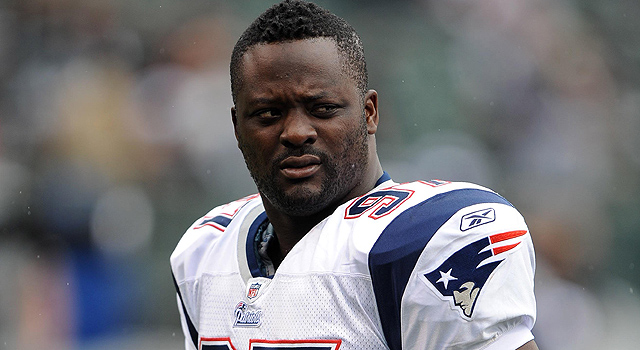
Tim Heitman/US Presswire
Former NFL defensive lineman Jarvis Green said stem-cell therapy has changed his life.
Former NFL defensive lineman Jarvis Green's decision to have stem-cell therapy on a torn-up knee wasn't just about football. It was also about quality of life. And 15 months after the procedure, from both a football and life standpoint, he has a message for Peyton Manning:
Good days are ahead.
Fox Sports NFL insider and NFL Network contributor Jay Glazer reported last weekend that the Colts quarterback, who's had three neck surgeries in 2011, including a September spinal fusion, went across the Atlantic Ocean to have the stem-cell treatment Green had done in an attempt to expedite the healing process and alleviate the associated pain. After that, it was revealed that Terrell Owens recently went to Korea to have a similar procedure.
Can Manning expect the results Green says he's gotten? That's unclear. "The only thing controversial about it," said renowned orthopedic surgeon Dr. Neal ElAttrache, "is that it's never been shown to work." Dr. James Gladstone, chief of sports medicine at Mount Sinai, adds, "It may turn out in some circumstances that it's a really good thing. In others, it may have no effect."
For his part, Green swears the therapy worked. In 2009, his final year with the Patriots, Green had two knee surgeries. The first, which he was told was "just a scope," took him months to recover. The second, coming during the season, took a month of games off the calendar for him. After playing out the year with New England, he bolted for Denver.
At minicamp the following June, his knee worsened to the point where he said it was "bone-on-bone." In an effort to hide a brace and heavy bandaging, he wore sweatpants. He says he had a good few days of practice, but he knew something was wrong. And he searched for answers.
"After minicamp, I couldn't walk up and down stairs, I couldn't play tennis with my kids. Nothing," Green said.
Stem-cell therapy is what he found. He went to a doctor in Bloomington, Colo., keeping all this from the Broncos. The process had doctors extracting bone marrow from his hip and harvesting it for three weeks. That substance was then injected into Green's knee. Green was told to wear knee braces for the next 10 days.
Within two weeks, he said everything changed.
It wouldn't be enough to save his football career. But it did give him a chance. Green passed the team's grueling conditioning test in July, just weeks after having the procedure done, and got some pretty serious returns away from the game as well.
"The pain was gone," Green said, adding that he plans to go to Europe to have the therapy on other areas of his body ravaged by football. "It was a tremendous difference in the pain level, my range of motion. It was amazing. I rented a house in Denver with an elevator, just to get by, and said nothing to coaches, because I was worried about getting cut.
"Two weeks later, I'm swimming and biking in the mountains. ... I went to camp, didn't miss a day of practice, ran every day, beat everyone in sprints."
Green has no doubt on the effects of the stem-cell therapy. Conversely, in the medical community, there's plenty of doubt.
"I can't recommend it until I've seen reasonably well-done studies on it," said ElAttrache, who did Tom Brady's ACL surgery and has worked for a half-dozen pro sports franchises. "What I know about that one particular type of treatment is that it's safe. I just don't know how effective it is."
Gladstone said, "I wouldn't say it's controversial. It's experimental. The effects and benefits of it are not known yet. We don't know whether it's a bunch of nonsense or if it's highly effective."
He related it to the concept of Platelet Rich Plasma, or blood spinning, a practice that came under scrutiny because of the involvement of Anthony Gallea, the Canadian doctor who pleaded guilty to bringing unapproved drugs such as human growth hormone into the U.S. Gladstone said where the idea of blood spinning is to promote healing through the separation of white and red blood cells, the concept of stem-cell therapy is to enhance healing.
"You get cells that haven't differentiated and haven't moved into whatever they're going to become, and you hope they become bone or cartilage or tendons," he explained. "It settles into an area that's injured, and the hope is it develops into the type of cell needed to heal that injury."
When asked if going to Europe to have the procedure done was a sign of desperation, ElAttrache -- who emphasized that he did not know the specifics of the Colts quarterback's treatment, and suspected it could even have been the kind of plasma treatment Kobe Bryant, Tiger Woods and Rafael Nadal had overseas -- responded that he didn't think Manning was going out on a limb by making the trip. Rather, it was exhausting another option.
In fact, he says he could see why the plasma treatment would be tempting. "If someone tells you it's natural, and that it's not going to harm you or delay healing, it might be attractive for someone with a chronic issue like arthritis," said ElAttrache.
ElAttrache added he thinks Manning has a "reasonable shot" of being available later this year, whether the treatment is effective or not. The course of the spinal fusion, the doctor says, is relatively predictable and can be expected to be effective. It's the nerve regeneration, which would bring back the power in his right arm and hand, that is less predictable. On the low end, ElAttrache says, that part will take 3-4 months. More likely, it'll shelve Manning for 9-12 months, making training camp in 2012 a better bet than December.
But the bottom line here is that ElAttrache sees the stem-cell therapy Manning had as highly unlikely to steady that part of it. It may help the healing process, particularly with anti-inflammatory effects, but if the regeneration happens in time for Manning to come back this year, the doctor says, it's probably not because of that trip overseas.
Meanwhile, in Colorado and with his new construction company in North Dakota, Green says he's living a better life because of the treatments. And his belief is that this chain of events starting with this therapy is no coincidence.
"They're working miracles," said Green. "I'm gonna go overseas again, because it works. I'm not 100 percent, but I'm playing football with my son. Stem-cell therapy, it does work, and it could help so many players out there."
Manning, of course, hopes it works for him. How much could it? That seems to be very much up for debate.
George Church, the geneticist behind the Personal Genome Project, is envisioning a package deal: get your genome sequenced, and he and his collaborators will develop a line of induced pluripotent stem cells (IPS) from your tissue, so in the future, you’ll be able upgrade your system with organs and tissues bearing both your genes and special extras like genes from centenarians. It’s combining stem cells with gene therapy. In an interview with Church, David Duncan-Erwin over atTechnology Review asks him to elaborate. Why does he think this science fiction scenario is in our near future?
I don’t think people have fully appreciated how quickly adult stem cellsand sequencing and synthetic biology have progressed. They have progressed by orders of magnitude since we got [induced pluripotent stem cells]…
Let’s use stem cells in bone marrow as an example. They are easy to use and to get to work when you implant them in bone marrow. You might one day have three choices. You can have bone marrow [1] from someone else that is matched to you, or [2] that is from you, or [3] bone marrow that is matched to you and comes to you, but is better than you. This better bone marrow might be [engineered to be] resistant to one virus, or to all viruses. It could have a bunch of alleles that you picked out of super centenarians, alleles that you have reason to believe are at least harmless and possibly helpful…And you will be able to do that for almost every stem cell population. Some of them are a little bit harder to replace, though.
IPS cells have already been used to grow an entire mouse from nearly scratch, he points out, and many crucial experiments have already been performed in rodents, so for human testing, “we’re talking about years, not decades,” he says. “It’s shorter than the Human Genome Project [which took 13 years], not less expensive, but definitely shorter.”
And how will this catch on? Here, Church shows that he understands the dynamics of translational medicine and the media very well:
The only way people are going to get this is through some brave soul. It will start with a sick person, and they will end up getting well, possibly more well than before they got sick. So you didn’t just correct the sickness, you actually did more. And they’ll give testimonials, and someone from the New York Times will interview them, and tell this appealing anecdote.
With that, they’ll be off and running.
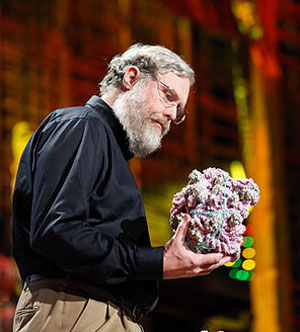
Biologist George Church, examining a molecular model.
Skylie Milton’s grandma held out a cracker while standing on the other side of the room.
“Come on, Skylie, come get a cracker,” she said.
The 14-month-old Billings girl whipped her head around, smiled from ear to ear and hobbled across the living room toward the snack.
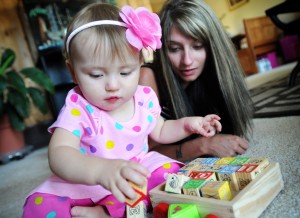
JAMES WOODCOCK/Gazette Staff
Kaile Milton plays with her 14-month-old daughter, Skylie. Skylie recently had stem cell surgery in China to correct blindness caused by septo-optic dysplasia. Skylie and her family spent 28 days in China for her treatment.
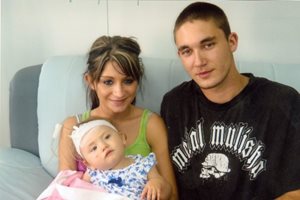
Milton family
Kaile and Chad Milton sit with Skylie at the hospital in China where the toddler received stem cell injections to improve her eyesight.
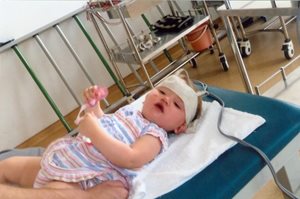
The Milton family
Skylie receives stem cell injections through her head at the hospital in China.
Once Skylie got within its grasp, she reached out, took the cracker and brought it to her mouth.
It’s something she couldn’t have done just a few months ago when she could see only about a foot away.
Thanks to stem cell research, and $40,000 raised by the community to send Skylie to China for stem cell injections, the giggling girl can now see just beyond 25 feet.
“It’s just amazing, it’s awesome,” said Skylie’s mom, Kaile Milton.
Lying beside Skylie on the floor as she played with blocks, Milton still seemed to not believe her girl could see.
The doctors in China shared her amazement, Milton said.
“They were surprised she took to it so well,” Milton said. “Usually they don’t see that much progress that quickly.”
Because the type of stem cell therapy the family settled on is considered experimental in the United States, the family had trouble finding a doctor in the area who would support them. It was further research that led them to China.
Skylie and her parents, Kaile and Chad, along with grandma Tammy Rel, traveled in July to Quing Dao in China and the Chengyang People’s Hospital, where they stayed for about a month.
During that time, Skylie received seven stem cell injections geared toward improving the her eyesight.
Skylie was born missing her septum pellucidum, the part of the brain that separates the right and left hemispheres. Without it, her optic nerves never fully developed, diminishing her eyesight.
In addition, doctors determined that Skylie suffers from septo-optic dysplasia, which affects both her eyesight and the hormones related to the pituitary gland. It affects about 1 in 10,000 births, according to the National Library of Medicine.
To improve their daughter’s eyesight, the Miltons settled on stem cell injections and then looked to the community for help. The response was overwhelming.
The person who stands out the most to Milton’s mind is Dana Lariviere of Billings, who volunteered to head a fundraiser that helped raise more than $11,000.
“We wouldn’t have made the trip without them all,” Milton said.
In China
The family was able to stay in a room at the hospital, putting them close to Skylie during her 28 days abroad.
Most of the injections were given through her arm, though a few had to be given through her head.
“Watching the IV was horrible,” Milton said. “One day they had to poke her seven times, then eventually just had to put it in her head. But she took to it really well.”
To help soothe the child, the doctors would sing her “Old MacDonald” — in Chinese.
When she wasn’t receiving an injection, Skylie was undergoing rehabilitation treatments to help keep her blood flowing and the stem cells stimulated, including acupressure, electrical stimulation, walking training and cup therapy five times a week.
To continue her progress, Milton said they make sure to massage around her eyes and her head.
It’s unknown whether Skylie will need additional stem cell injections through the procedure, which is not available in the United States.
Not alone
During Skylie’s treatment, the Miltons met two other couples going through the same procedure, both from the United States.
When they weren’t waiting in the hospital, the group was able to go into the city and take in the culture.
It was quite a shock, especially seeing strangers’ adoration for Skylie.
“We couldn’t even go to the store, it would take an hour to get down the aisle,” said Rel, the grandmother. “People were taking pictures with her.
“They were very warm and loving toward her; we couldn’t keep her away from everyone.”
DESPITE MISINFORMATION AND LIES FROM A PHONY PHARMA-BACKED "IRISH STEM CELL FOUNDATION," THE HOGANS WILL ACCEPT THE GIFT OF RENEWED LIFE OFFERED THEM.
An anonymous donor has offered to pay the entire cost of specialist surgery for a man who is hoping to see and walk again after a vicious assault left him blind and paralysed.
Arian Hogan (34) from Ballykeefe, Co Limerick, is hoping that a complex stem cell procedure -- estimated to cost at least 21,000 euros -- in the US will allow him get his life back on track.
Confined to a wheelchair, Mr Hogan burst into tears this week when he learnt that an unidentified person was willing to cover the cost.
The generous benefactor contacted Headway -- an organisation which provides rehabilitative services for people with brain injuries -- and informed them of her wishes to provide full financial backing for Mr Hogan.
The identity of the woman is unknown to the Hogan family and she wishes to remain anonymous.
Mr Hogan's sister, Nevis, said they are extremely grateful and cannot thank her brother's donor enough.
"We have no idea who she is. They rang Headway in Dublin and then got onto the Limerick offices and they let us know. What can we say? -- Only thank you over and over again," Ms Hogan said.
The Hogan family had been fundraising for the unique stem cell treatment which will be overseen by Dr Gabriel Lasala near New Orleans. They are waiting for a phonecall to find out when Brian's treatment can begin.
The Irish Stem Cell Foundation said treatments using stem cells only exist for a handful of blood related cancers and rare blood disorders and have urged any patients considering such options to speak with medical professionals beforehand (medical "professionals" who will tell them that because THEY have sentenced Arian to a miserable paralysed life and can do nothing about it, he should listen to their lies and suffer---Don Margolis)
Ms Hogan admits there are no guarantees with the procedure. "We have done our research, but put any family in our shoes and what would they do? We know there is no guarantee with stem cell treatments, but we have one shot with this and we want to give Brian every chance. There might be success, there might not, but we'll see," she said.
Mr Hogan went into a three month coma after suffering internal bleeding of the brain when he was punched and struck his head off a footpath in Nottingham, England, in 2009.
He currently lives at Beech Lodge Nursing Home in Bruree, Co Limerick, while his parents remodel their home for him. "We want to thank everyone who has supported Brian so far. There have been people who have helped out in any way they could," Ms Hogan added.
Read more:
http://www.belfasttelegraph.co.uk/news/local-national/republic-of-ireland/anonymous-donor-to-fund-us-stemcell-surgery-for-attack-victim-16047330.html#ixzz1XReQwmZW
Jason Casley describes how daughter Meg's cerebral palsy improved following world-leading stem-cell brain-surgery.
Would you consent to having your child's brain operated on, in the hope that it might help a particular condition, but with no guarantees?
Jason and Meg Casley
That was the very difficult question Freeburgh's Jason and Kate Casley had to grapple with in March 2010, when they took their 2-year-old daughter, Meg, for groundbreaking stem-cell surgery in Germany to help her cerebral palsy.
18 months on, and with Meg now 3-and-a-half, how has that surgery on Meg's brain changed her life?
"Immediately one of the big things we noticed was the spasticity across her shoulders reduced, so she was able to relax. The biggest thing, without a doubt, was her immune system. We used t be in and out of the local hospitals, it felt like every second week. Because if meg picked up anything, it went straight to a major infection. Following the treatment, we virtually went an entire winter season with only a couple of minor ailments."
However, with the risks involved, and no guarantee that the surgery would help Meg, Jason and Kate went through a change of heart more than once before making that final decision for Meg.
"Yes we did. And we sat down and we talked about it at length in the evenings to try and work out how we were going to do what we were going to do. Because let's face it, there is no magic bullet that's going to remove Meg's cerebral palsy. But if we can make little changes that help her develop from that point, so in later life she is able to maximise her potential, and her indepependence, and being able to do things for herself - anything - then it's worth doing."
Jason says the trip to Germany would not have been possible without the amazing local support and that he and Kate have been overwhelmed by the help they have received.
"The local community support was fantastic and we couldn't have achieved what we did without it."